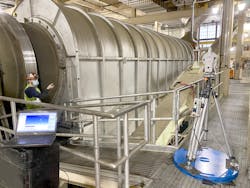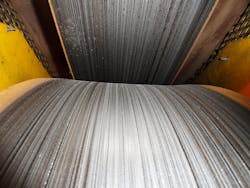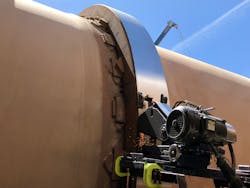Basic (but essential) rotary drum maintenance
Few types of industrial equipment are as ubiquitous as the rotary drum. This diverse machine is used in applications ranging from high-temperature thermal processing to cooling to granulating and much more.
Despite carrying out such different tasks across a host of industries, however, many aspects of rotary drum maintenance are universal. The following covers some of the high-level concepts that apply to rotary drums, no matter what industry they are working in or what material they are processing.
Why maintenance is important
Rotary drums are a substantial capital investment in any setting but can provide decades of reliable processing when properly maintained. And yet, simple maintenance procedures are often neglected or overlooked.
Author Olin Miller once said, “If you want to make an easy job seem mighty hard, just keep putting off doing it.”
While Miller was undoubtedly not thinking about rotary drums when he penned his famous quote, the sentiment certainly applies. The consequences of ignoring rotary drum maintenance can be catastrophic, and the longer maintenance is put off, typically the more work, time and expense that is needed to correct the issue.
As such, having a solid preventative maintenance plan in place is one of the easiest ways to avoid disastrous problems down the road.
Keep in mind that the operating conditions placed on rotary drums make each setting unique. While this article provides general guidance, always follow the recommendations set forth by the original equipment manufacturer.
Inspections
Regular inspections are the first step in a preventative maintenance plan. Operators and maintenance personnel should be trained in what to look for and when to conduct inspections. Inspections are best carried out on a daily, weekly, monthly and yearly basis, with the criteria for each examination changing.
Daily
Operators should conduct a daily walk-through, visually inspecting the entirety of the drum and its surrounding components to look for signs of abnormality and ensure all safety guards, labels and signs are properly in place. Operators should also check the contact between tires and trunnions, and between tires and thrust assemblies on a daily basis.
Weekly
Weekly, operators should evaluate the condition of bearings and thrust roller assemblies, graphite blocks (to confirm tire lubrication) and gear or chain lubrication. Tire wear should also be assessed on a weekly basis.
Monthly
Internals should be checked on a monthly basis, or as production schedules allow. Chain tension, alignment and lubrication (when applicable) should also be examined each month. Other components that should be inspected as part of a monthly dynamic inspection include:
- V-belt
- Reducer
- Couplings
- Bearings for trunnion wheel and pinion drive (if applicable)
- Thrust assembly
- Hammers (where applicable)
- Drum shell
- Graphite blocks for tire lubrication
Every six months
Components less likely to experience constant wear, such as hammers (where applicable) and breeching seals can be inspected every six months.
Annually
Even when preventative maintenance schedules and inspections have been followed, rotary drums should be inspected annually by a qualified technician. This inspection may vary based on the provider, but typically includes a complete and thorough review of the drum’s mechanical components, identifying potential wear items and areas in need of attention. The information gathered during an annual inspection (or any inspection for that matter) also provides valuable benchmark data for maintenance planning.
Routine realignment
A rotary drum is a carefully balanced system. Proper alignment of the drum ensures that despite the constant rotation, heat stresses (where applicable) and static and dynamic loads, the system and all of its components are mechanically balanced for optimal performance and minimal wear.
Rotary drums naturally fall out of alignment over time through normal operation. When they begin falling out of alignment, additional stress is put on all components. The more out of alignment the drum falls, the greater that stress becomes.
If left untreated, misalignment accelerates wear on all components and leads to more serious problems such as tire and trunnion wear, bearing failure and gear damage, among other things.
Depending on the service provider, realignment may be conducted manually or with the use of a laser alignment system. A laser alignment system provides faster, more precise alignment and is beginning to replace the traditional method of manual alignment.
Tire and trunnion grinding
As the load-bearing components and point of rotation, the tires and trunnions provide the structural support to the drum and promote smooth rotation. They are also under constant load and friction, and apart from the internals, are usually the first to show signs of wear in the event of a problem.
There are numerous potential causes of tire and trunnion wear, ranging from a misaligned drum, to fugitive material, improper lubrication and more. Because of the critical structural role these components play, any signs of wear should be immediately addressed.
When either the tires or trunnions begin to wear, the drum becomes mechanically imbalanced and again, puts added strain on all components, which exacerbates as the problem continues untreated.
Wear on either tires or trunnion wheels can be resolved by grinding away the damaged surface to reveal the like-new surface below. Grinding, which is carried out by a trained technician using a specialized device, can address minimal-to-moderate wear such as pitting, spalling and timing marks. More severe damage may require tire and/or trunnion replacement. If a tire or trunnion has lost 10% or more of its original diameter, replacement is recommended, as beyond this, the drum slope, which affects several process parameters, begins to change. Seal rings will also start to drag on the drum at this point.
Because tire and/or trunnion grinding changes the base of the drum, a realignment should always be conducted after grinding.
If tire replacement is necessary, consider upgrading to a floating tire assembly. This approach to tire mounting has become an industry standard for the many benefits it offers over previous designs. Floating tires prevent drum shell distortion, allow for thermal expansion (where applicable), reduce operating stress on the drum and promote easier maintenance.
Maintain proper float
Rotary drum “float” refers to the positioning of the drum between thrust rollers, with the drum ideally floating between them, not riding hard against one or the other. Thrust rollers are positioned at each tire on both sides of the tire.
Optimal float ensures that the drum is not putting excessive pressure on either the uphill or downhill thrust roller, which prevents the drum from drifting longitudinally.
As with alignment, drums naturally fall out of proper float over time, requiring routine adjustment. If not adjusted, the drum will continue to put increasing pressure on the affected thrust roller and tire, ultimately damaging either or both, rendering the drum mechanically unstable and reducing the overall longevity of the unit.
To remediate a drum that is not floating properly, drum training is conducted. This is a practice in which trunnion bearings are skewed at small increments to encourage repositioning of the drum along its longitudinal axis. Proper training is vital, as even small adjustments made improperly can cause severe damage.
Replacing the internals
As the components most in contact with the material being processed, the rotary drum internals are typically the first to wear. Depending on the material being processed, the specific processing conditions and the drum design, wear may occur rapidly or over a long period of time.
Depending on the type of drum (dryer or coating drum), the internal components may serve as a means of protecting the drum shell from corrosion and/or abrasion, or may contribute to processing efficiency.
In either case, the performance of internals is essential, and as such, worn internals should be refurbished as needed. Operators and maintenance personnel should routinely monitor the condition of internals as the production schedule allows.
Clean out as production allows
Depending on the material and the production setting, regular cleanout of the drum is typically a good idea. A good cleaning helps to reduce and prevent buildup, as well as discourage corrosive wear. It also gives operators a chance to review the drum’s internals more closely, allowing them to check for any potential damage.
Routine maintenance and repairs
It should go without saying that keeping up on routine maintenance and repairs is critical. Ensure all components are properly lubricated, change oil in gearboxes as necessary and replace worn components as needed. Keeping up on this type of maintenance is an easy way to prevent more severe problems down the road.
Operator training
Though not a direct maintenance practice, it is worth noting that proper operation contributes significantly to the longevity of a drum and the amount of maintenance it will require.
Plant managers should ensure that rotary drum operators, as well as maintenance personnel, are adequately trained on the drum. In addition to being a generally good practice, training can avoid catastrophic mistakes, such as running a burner while the drum is not in rotation (this would cause localized heating that could create deformity in the shell).
Properly trained operators are also better able to identify potential problems and address them before they have the opportunity to escalate.
Conclusion
No matter what industry they are employed in or what material they are processing, rotary drums of all types have one thing in common: they depend on proper maintenance procedures to continue providing reliable and efficient service.
Following a regular inspection schedule, routinely having the drum realigned, resurfacing tires and trunnions as needed, and the other practices mentioned here are the best way to ensure a rotary drum with a long service life and minimal downtime. Those experiencing issues with their drum should seek a qualified service provider to repair the drum and minimize any potential damage.
FEECO International



